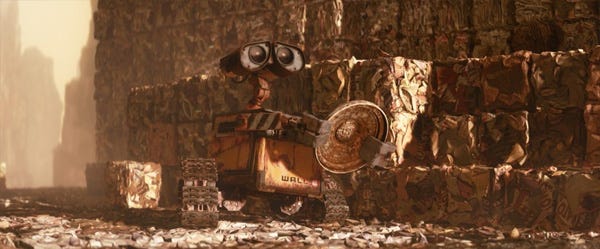When you put people in a box, they will either comply or defy. Either way, being boxed in will limit their ingenuity.
Let’s illustrate with a vignette from the misspent youth of a mischief-making imbecile.
At 13, I got acquainted with the magic of kiln-fired ceramics. In goes a blob of clay, its shape conveying the futility of inept hands, littered with jagged ridges and haphazard thumb impressions.
Then, the magic. Much like my Gaelic complexion, mishandled clay looks a lot better after some time in the heat. And what emerges is, like me, a somewhat recognizable artifact.
Kiln-crafted nick-knacks are not merely the wondrous kitsch keeping shelf manufacturers in business. Each is a lasting testament to the fledgling artistic skill of its creator. And by lasting, I mean it’ll be stumbled upon in a landfill many eons from now when automated cleanup droids are restoring the planet.
Of the many means of permanently afflicting the world, the forsaken immortality of unrequited artistic genius is among the more charming. So said Mr. Wes Gopnik, the rotund and bespectacled “art teacher” incessantly streaming such unbidden insights as a backing track while tweenagers equal parts incurious and incapable actively worked to tune him out. In his earnest attempt to dispense wisdom, he unwittingly prepared us to cope with looped messages blared from a prison camp loudspeaker.
The air thick with Old Spice and ennui, we became aware of a break in the perpetual hum of Gopnik’s blather. Clearing his throat, he then grappled for a ceremonious tone, signaling an important announcement.
We had a project, he said. It would serve as the capstone of our intensive study of incompetent clay-making and would be worth half our semester grade. This managed to pierce our collective apathy, as the one thing no one wanted was a repeat custodial sentence in this classroom. Despite his many limitations, Gopnik had managed to create an interest for us to vindicate by actually following instructions.
The project was to create something we could use around the house. Upon completion of our attempts at molding, or the expiration of time available for such attempts, the objects would be placed into the magic hot box at two thousand degrees. We would then paint them, or not, and take them home.
Gopnik issued two rules for the task.
“First, no fruit.”
He pretended it was because the density of the objects created a baking problem, remaining somewhat dissolute at their cores and therefore lacking the structural integrity to mar a curio shelf for the requisite number of decades.
The actual reason was scandalous.
An entire class of twenty-three eighth-graders, rallied by three miscreant boys all surnamed Baker but unrelated, had crafted clay phalluses while claiming they were supposed to be bananas. Hesitant at the moment of truth, the unfortunate Gopnik had defaulted, allowing the objects to be baked and painted.
Suddenly, mantelpieces all over town showcased startling objects. Workaday serenity in common households gave way to dark dreams and unexplained sobbing. Therapists found themselves fully booked. Mortified grannies city-wide reached for a second glass of sherry with dinner.
Wielding faux shock as a sop for their allegedly conservative values, parents wondered aloud where their sweet children could possibly have gotten such a devilish idea. The three Bakers were tempting scapegoats, but everyone tacitly accepted they were merely mirrors reflecting the decrepitude of the at-large kid populace, which in turn reflected the cloaked moral malaise of the parent populace.
While the Bakers had blabbed to every man and his dog about the true nature of the incident, Gopnik managed to dodge the sack by pleading banana confusion. His penance was to “be more clear” with future instructions.
Hence, the fruit prohibition.
Secretly, school administrators wrung their hands, disinterested in a vain search for a unicorn willing to absorb a thousand hours per year of chicanery and abuse in exchange for a paltry wage, a static and skull-numbingly boring career, and zero recognition.
“Second, no ashtrays.”
For this rule, Wes provided no justification. Just an arbitrary constraint and a “because I said so.”
Before hearing the rules, my plan was to make a small bowl for my dad’s peanuts. The old man could put away a farmed hectare’s worth in a single episode of his favorite sasquatch hunting show.
When he reached the bottom third of the jar, a grim spectacle developed as he fumbled for elusive morsels, licking the salt from his fingers before repeating the cycle with increasingly gobby paws.
A decent bowl could end all that. And since my parents lacked the industry to either create or purchase a bowl, I would exploit my newfound kiln access to solve this pressing problem and restore household decency.
My plan was for a shallow, sloping bowl with a solid payload. Importantly, it had to feature a broad enough neck for the old man to get his mitts in there easily. Yet, there needed to be some narrowing to create an aura of encouraged forbearance, thereby magnetizing the obviously desirable thing being protected.
Such were the early machinations of a burgeoning military tactician.
But then Gopnik came along and told me what I couldn’t do. And that instantly changed my plan.
I became ideologically committed to creating an ashtray. Not because my parents both smoked, although they did, and that would have been a good reason.
But simply because there was an unjustified rule saying I couldn’t.
Defying the rule became more important to me than actually creating something meeting the intent of the exercise.
Upon seeing that I had created what was clearly intended to function as an ashtray, Gopnik challenged.
“That’s not an ashtray. It’s just a plate for a sandwich.”
“Then why does it have little slots on the side that look like resting places for cigarettes?”
“Those are just to put a few fries, or a pickle, or a toothpick. It’s a feature.”
Finding my logic immutable, Gopnik shook his dismayed noggin and moved along, directing me to label the “plate” as such. Obviously to protect his job.
Being the wryly clever operator I was, I simply scrawled something fictitious on the side to cover myself. Influenced by a recent screening of John Hughes’ terrible teen caper “Weird Science,” I imagined my ashtray as the vessel for a pork sandwich, and labeled it thusly.
Several classmates followed my lead, flooding the kiln with stealth ashtrays.
Some others stayed within the bounds set for them, creating variations of lame bowls. A pointless exercise for all involved, but at least the landfills wouldn’t go wanting.
There is a lesson here for organizational leadership, and I have seen it play out dozens of times.
Put people in a narrowly defined space and you will get either compliance or defiance.
Every thick line you draw to bound the conceptual canvas of activity imposes a psychological constraint. Something the participants aren’t allowed to do. They become more focused on staying inside the boundaries than on creating. They’re stifled. But they are compliant, and doing exactly what you (said you) wanted.
Others, like the antagonistic, self-amusing, easily triggered lad in the story above (who maintains the same temperament to this day) will feel disempowered by the imposition of too many limits. You can ease that feeling of lost power by explaining why a limit is necessary, but if you refuse to do so or spout gibberish, your actions will feel coercive, the reins too tight. Many people will take such tightening personally, as an affront to their inborn right to some semblance of ordinary freedom in ordinary activities.
As a general given rule, when you make people feel disempowered, they will find a way to feel more power.
In the sort of situation abstracted here, they may test boundaries without exposing themselves to the culpability of clearly violating them. They are defiant, creating something which actively nullifies the purpose of the activity.
Whether the limits you impose engender defiance or compliance, they take energy away from creativity.
If innovation is your goal, define as big a conceptual space as you can, impose as few limits as possible, and make the boundaries fuzzy enough that people don’t feel mentally constrained.
When you put people in an open space, you stand a much better chance of getting their best. And to innovate, you need exactly that.
Everything I say here makes natural sense. Put a lion in a cage, and it will try to get out until it realizes it can’t, at which point it will sit passively. Give a lion space to roam, and it will find the best hunting ground.
Unfortunately, this basic idea often gets lost in organizations as they grow, becoming beholden to myriad stakeholders, more exposed, and more risk averse.
There is a lot of talk about “safe innovation” from executives these days. This expression is a free range oxymoron.
Amazon’s CFO Brian Olsavsky remarked in ‘24 that the company would “continue to invest in new things and new areas and things that are resonating with customers.”
I don’t know what that means exactly, but it sounds like the approach is to make sure something will hit with customers before investing in it.
That imposes a fatal limit on creativity, essentially testing a proposal’s return-on-investment before it can even stand in the cradle.
Maybe we can argue that’s a decent framework for incremental improvement in a cost-sensitive environment.
But it’s a horrific framework for innovation, which is less about giving customers something already resonating with them and more about giving them something they haven’t even imagined yet, but you’re confident they will love.
You don’t find those sorts of ideas by telling people to make different forms of clay bowls.
Sticking with Amazon as an example, mass layoffs and reduced focus on new products and services reflect a desire to grow by shrinking. This doesn’t work. It provides short term relief from cost pressure at the expense of long-term success, because shrinking the space in which people create makes ingenuity too rare to seed the future.
There are many reasons to resist over-controlling groups of people. Among them the injury to business interests. Because when you put people in a box, they will either comply or defy. Either way, the distraction of being boxed in will limit their ingenuity.
Great companies become great because they create new things. And at least for now, hopefully forever, building things for human consumption still requires human ingenuity.
Companies regress into mediocrity by pushing their people and culture into creative frustration, resulting in a comply or defy response to onerous limits on free thought.
True creation means taking the chance your efforts might come to nothing. Like what happened with my sandwich tray.
TC is a writer, speaker, and organizational leadership expert with more than thirty years in the arena as a combat pilot, commanding officer, operations director, and veteran voice.








